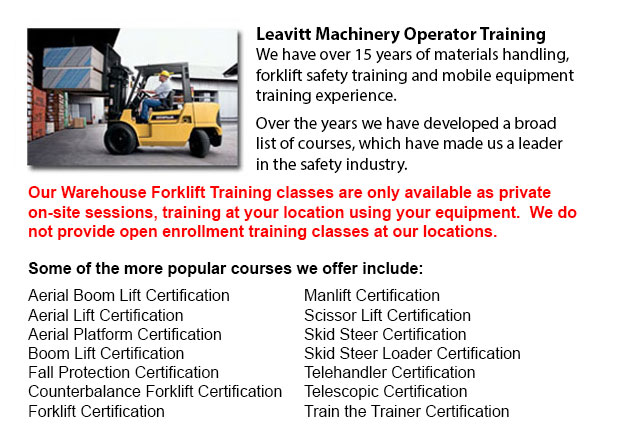
Markham Warehouse Forklift Training Programs - Warehouses could be retail, industrial or commercial facilities. Their function could range from product distribution to retailing bulk products. Regardless of the type of warehouse, workers within warehouse settings should be trained well in safety measures related to material handling and storage, conveyor systems, loading docks, and pallet jacks and forklifts. Good housekeeping is vital to an orderly and safe warehouse setting.
Truck and loading dock systems are often situated at a height from the ground. Products exit and enter warehouses through these systems where workers unload and load materials from elevated docks and ramps. Particular attention must be paid to safety practice in this stage. To be able to prevent falls, install yellow striping along the edge of ramps and docks. Pay attention to the area around delivery trucks which are parked at the loading dock, especially the part between truck and dock. Be certain that truck wheels are chocked when unloading.
Some warehouses utilize conveyor systems to distribute products inside the facility. Conveyor systems have moving belts and wheels that pose a pinch point danger. Keep hair and parts of the body well away from conveyors to avoid injury. Elevated conveyors pose a hazard to staff under if safety nets are absent. Staff have to know how to stop conveyors in the event of emergency. Be aware of the location of emergency stop buttons and off switches. When servicing conveyors, tag out/lock out measures are mandatory.
Forklifts and pallet jacks are designed to move materials all-around the warehouse. Operators of forklifts are needed to take training and receive certification. Pallet jack operators do not require certification, but must be trained on the machinery. Training courses instruct operators in the proper ways for hoisting objects and transporting them to their assigned place. Neither forklifts nor pallet jacks must ever be utilized to lift or transport staff.
To allow for enough room for machines and individuals to pass, rack systems and storage shelving help to create an orderly and efficient work area, specially if they are properly braced. Careful and slow placement of good is required to prevent accidents caused by products falling off the facing aisle. Aisles must be kept clear by storing products flat and in the shelving units. Pallets are utilized for stacking products. They should be in good condition, and palleted products must be baled or shrink-wrapped, whenever possible.
Personal protective equipment (PPE) should be worn, as appropriate, to protect workers' heads, limbs, feet and hands. Hard hats or bump caps, steel-toed shoes and gloves are common PPE.
Slippery floors that are pocked with dents and pits may present significant hazards, making good housekeeping really vital. Warehouse docks and floors must be clear of dirt, debris and oil. The area should be kept clear of baling materials, garbage and boxes.
-
Markham Forklift Certification Schools
Markham Forklift Certification Schools - Forklift Certification is mandatory in North America. Hence, forklift training programs are essential both for businesses and for people seeking jobs in industries as forklift operators. Forklift training focu... More -
Telehandler Training in Markham
Telescopic handlers normally called telehandlers for short, are a very popular piece of heavy construction equipment. They are commonly utilized in the construction and agricultural trades. These machines have maximum reaching capability and can get... More -
Markham Zoom Boom Training
Markham Zoom Boom Training - Zoom Boom Training is designed to train operators on variable reach forklifts. The objectives of the training are to impart an understanding of the physics of the machinery, and to outline the operator's tasks. This progr... More -
Markham Heavy Equipment Ticket
Markham Heavy Equipment Ticket - A heavy equipment operator will utilize different construction machinery, depending upon the nature of the task at hand. The large equipment are constructed to carry out specific tasks in the most efficient method for... More -
Markham Scissor Lift Training
Markham Scissor Lift Training - When operating a scissor lift, they must be utilized competently so as to protect the safety of the other employees inside the workplace and to protect the safety of the machine. Competent operators are trained to driv... More -
Markham Manlift Operator Training
Markham Manlift Operator Training - The aerial lift or manlift is a specialized kind of hydraulic platform which is designed to raise a person vertically giving it an alternate name of a vertical personnel lift. These machines are widely used for a m... More -
Markham Heavy Equipment Training
Markham Heavy Equipment Training - The two most common kinds of heavy equipment training are classed into the categories of machinery; equipment that is fashioned with tracks and those with rubber tires. The tracked vehicle are heavy duty equipment s... More -
Markham Forklift Safety Training
Markham Forklift Safety Training - Those wanting work in industries that utilize forklifts should undergo a forklift safety training course before becoming a certified operator of a forklift. There are various ways to go about getting forklift safety... More

Forklift Certification Markham
TOLL FREE: 1-888-254-6157
Markham, Ontario
forkliftcertificationmarkham.com
Email Us
About Us


